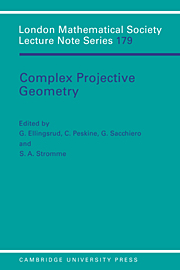Book contents
- Frontmatter
- Contents
- INTRODUCTION
- PROJECTIVE VARIETIES
- VECTOR BUNDLES AND SPECIAL PROJECTIVE EMBEDDINGS
- LIST OF PARTICIPANTS
- Speciality one rational surfaces in P4
- Bounding sections of bundles on curves
- The smooth surfaces of degree 9 in P4
- Compactifying the space of elliptic quartic curves
- Threefolds of degree 11 in P5
- Complete extensions and their map to moduli space
- On the Betti numbers of the moduli space of stable bundles of rank two on a curve
- Gaussian maps for certain families of canonical curves
- Geometry of the Horrocks bundle on P3
- Stability and restrictions of Picard bundles, with an application to the normal bundles of elliptic curves
- Sections planes et majoration du genre des courbes gauches
- A tribute to Corrado Segre
- Un aperçu des travaux mathématiques de G.H. Halphen (1844–1889)
- The source double-point cycle of a finite map of codimension one
- Fibré déterminant et courbes de saut sur les surfaces algébriques
- Courbes minimales dans les classes de biliaison
- Fano 3-folds
- Polarized K3 surfaces of genus 18 and 20
- Protective compactifications of complex afflne varieties
- On generalized Laudal's lemma
- Sur la stabilité des sous-variétés lagrangiennes des variétés symplectiques holomorphes
- Introduction to Gaussian maps on an algebraic curve
- Some examples of obstructed curves in P3
Protective compactifications of complex afflne varieties
Published online by Cambridge University Press: 06 July 2010
- Frontmatter
- Contents
- INTRODUCTION
- PROJECTIVE VARIETIES
- VECTOR BUNDLES AND SPECIAL PROJECTIVE EMBEDDINGS
- LIST OF PARTICIPANTS
- Speciality one rational surfaces in P4
- Bounding sections of bundles on curves
- The smooth surfaces of degree 9 in P4
- Compactifying the space of elliptic quartic curves
- Threefolds of degree 11 in P5
- Complete extensions and their map to moduli space
- On the Betti numbers of the moduli space of stable bundles of rank two on a curve
- Gaussian maps for certain families of canonical curves
- Geometry of the Horrocks bundle on P3
- Stability and restrictions of Picard bundles, with an application to the normal bundles of elliptic curves
- Sections planes et majoration du genre des courbes gauches
- A tribute to Corrado Segre
- Un aperçu des travaux mathématiques de G.H. Halphen (1844–1889)
- The source double-point cycle of a finite map of codimension one
- Fibré déterminant et courbes de saut sur les surfaces algébriques
- Courbes minimales dans les classes de biliaison
- Fano 3-folds
- Polarized K3 surfaces of genus 18 and 20
- Protective compactifications of complex afflne varieties
- On generalized Laudal's lemma
- Sur la stabilité des sous-variétés lagrangiennes des variétés symplectiques holomorphes
- Introduction to Gaussian maps on an algebraic curve
- Some examples of obstructed curves in P3
Summary
Introduction
In this paper we look at the following two problems:
Compactification problem:Let X be a smooth complex projective variety, A a divisor on X such that X\A is biregular to an affine homology cell, i.e. a smooth affine scheme with the homology groups of a point. Classify all pairs (X, A)!
Characterisation problem:Let V = Spec(R) be a smooth complex affine scheme. Characterise V by topological or algebraic properties of V itself and at infinity (i.e. of suitable smooth compactifications).
We will present known results about these two problems as well as their relation to other topics like Fano varieties and homogenous spaces.
Our problems are obviously related by the process of compactification which is due to Nagata in this category. Therefore results about one of these problems will give information about the solution of the other.
The compactification problem was first stated by Hirzebruch (see [H]) in the category of complex manifolds: Let X be a complex manifold with an analytic subset A such that X\A is biholomorphic to Cn. Then (X, A) is called a complex analytic compactification of Cn. Problems 26 and 27 in [H] ask for the classification of all pairs (X, A). By the theorem of Hartogs it follows that A has to be a divisor in X, hence this is a special case of our compactification problem in the complex analytic case.
The characterisation problem was attacked by several people, including Ramanujam [R] and [Mi].
In the sequel we give an overview of some of the results, in particular concerning the case of 3-dimensional varieties.
- Type
- Chapter
- Information
- Complex Projective GeometrySelected Papers, pp. 277 - 283Publisher: Cambridge University PressPrint publication year: 1992



